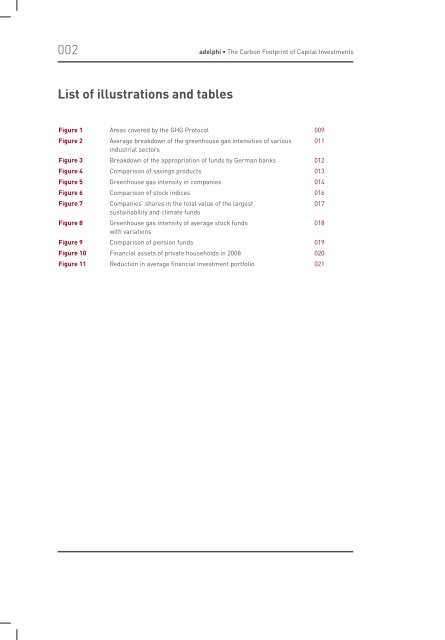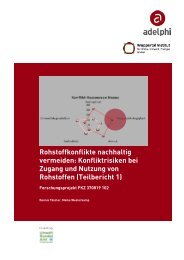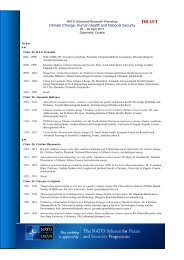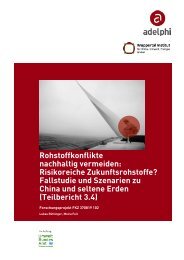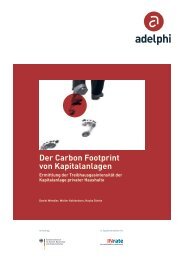The Carbon Footprint of Capital Investments - adelphi
The Carbon Footprint of Capital Investments - adelphi
The Carbon Footprint of Capital Investments - adelphi
You also want an ePaper? Increase the reach of your titles
YUMPU automatically turns print PDFs into web optimized ePapers that Google loves.
002<br />
<strong>adelphi</strong> • <strong>The</strong> <strong>Carbon</strong> <strong>Footprint</strong> <strong>of</strong> <strong>Capital</strong> <strong>Investments</strong> <strong>adelphi</strong> • <strong>The</strong> <strong>Carbon</strong> <strong>Footprint</strong> <strong>of</strong> <strong>Capital</strong> <strong>Investments</strong><br />
003<br />
List <strong>of</strong> illustrations and tables<br />
1 Introduction<br />
Figure 1 Areas covered by the GHG Protocol 009<br />
Figure 2 Average breakdown <strong>of</strong> the greenhouse gas intensities <strong>of</strong> various 011<br />
industrial sectors<br />
Figure 3 Breakdown <strong>of</strong> the appropriation <strong>of</strong> funds by German banks 012<br />
Figure 4 Comparison <strong>of</strong> savings products 013<br />
Figure 5 Greenhouse gas intensity in companies 014<br />
Figure 6 Comparison <strong>of</strong> stock indices 016<br />
Figure 7 Companies' shares in the total value <strong>of</strong> the largest<br />
017<br />
sustainability and climate funds<br />
Figure 8 Greenhouse gas intensity <strong>of</strong> average stock funds<br />
018<br />
with variations<br />
Figure 9 Comparison <strong>of</strong> pension funds 019<br />
Figure 10 Financial assets <strong>of</strong> private households in 2008 020<br />
Figure 11 Reduction in average financial investment portfolio 021<br />
<strong>The</strong> capital <strong>of</strong> private investors worldwide finances<br />
industrial and commercial activities which<br />
contribute substantially to global greenhouse gas<br />
emissions. <strong>The</strong> results <strong>of</strong> this study show how, for<br />
example, the five largest stock funds in Germany<br />
alone – representing managed assets <strong>of</strong> 20.7<br />
billion euros – contribute to the financing <strong>of</strong> over<br />
23 million tonnes <strong>of</strong> greenhouse gas emissions<br />
a year. Extrapolated to the totality <strong>of</strong> all German<br />
stock funds 1 , that means some 200 million tonnes<br />
<strong>of</strong> greenhouse gases to which private investors<br />
are substantially contributing, either directly or<br />
indirectly through institutional investors. That<br />
corresponds to 20 % <strong>of</strong> all Germany's greenhouse<br />
gas emissions (UBA 2010).<br />
Private households in Germany held financial<br />
assets totalling 4.64 trillion euros in 2009<br />
(Deutsche Bundesbank 2010). <strong>The</strong>se enormous<br />
investment sums can perform a key controlling<br />
function in financing climate protection and<br />
in the transition to a low-carbon economy. By<br />
their choice <strong>of</strong> where to commit their money,<br />
investors determine the capital investments <strong>of</strong><br />
tomorrow. <strong>The</strong> study shows how private investors,<br />
by choosing climate-friendly and sustainable<br />
financial investment products, can reduce their<br />
personal carbon footprint and thus fulfill their<br />
role as capital providers in a climate-conscious<br />
manner.<br />
Climate-friendly and sustainable capital investment<br />
products have major potential for further<br />
growth. Despite growing consumer awareness and<br />
rising demand for climate-friendly products, the<br />
market potential for financial investment products<br />
giving due consideration to climate protection<br />
issues remains largely untapped. Demand for<br />
these products is restricted by inadequate<br />
consumer education, a lack <strong>of</strong> market transparency<br />
and a shortage <strong>of</strong> awareness among financial<br />
advisors as to available forms <strong>of</strong> investment.<br />
On the consumer goods market, the "product<br />
carbon footprint" provides a guide for climateconscious<br />
consumers to assess the impact <strong>of</strong><br />
consumed products on the climate. However, no<br />
method has yet been established to indicate the<br />
product carbon footprint <strong>of</strong> financial investments.<br />
Investors in Germany are therefore unable to judge<br />
the emissions generated by the capital they invest.<br />
In view <strong>of</strong> that fact, this scoping study by <strong>adelphi</strong>,<br />
in cooperation with INrate, represents an initial<br />
attempt to determine the average carbon<br />
footprint <strong>of</strong> the German investment portfolio.<br />
With the greenhouse gas emissions <strong>of</strong> selected<br />
capital investment products calculated by INrate,<br />
<strong>adelphi</strong> reveals the emissions financed by private<br />
investors' capital investments and indicates<br />
the savings potential in German investment<br />
portfolios. <strong>The</strong> study also demonstrates to private<br />
investors and financial services providers how<br />
the carbon footprint is applied with regard to<br />
capital investments. This enables them to utilise<br />
the opportunities <strong>of</strong>fered by climate change, to<br />
minimise its risks and at the same time to make a<br />
key contribution to climate protection efforts.<br />
1<br />
German stock funds manage assets with a total value <strong>of</strong> 192,205 billion euros (BVI 2010).


